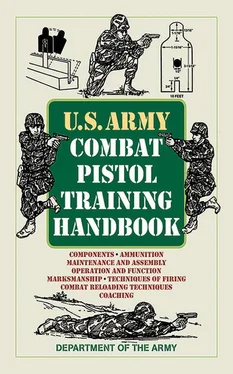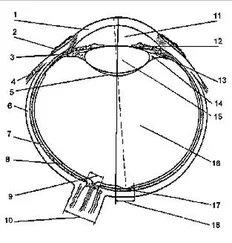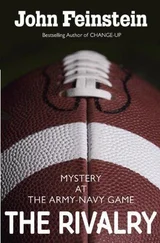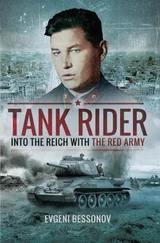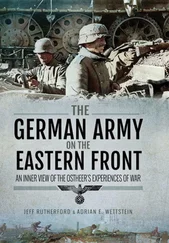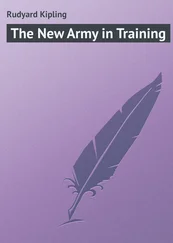b. The firer has the required ammunition and understands the commands for loading and unloading.
c. The firer complies with all commands from the tower operator.
d. Firers maintain proper alignment with other firers while moving downrange.
e. Weapons are always pointed downrange.
f. Firers fire within the prescribed range limits.
g. Weapons are cleared after each phase of firing, and the tower-operator is aware of the clearance.
h. Malfunctions or failures to fire that are due to no fault of the firer are reported immediately. On command of the tower operator, the weapon is cleared and action is taken to allow the firer to continue with the exercise.
NOTE:For training and qualification standards, see Appendixes A through D.
APPENDIX A*
COMBAT PISTOL QUALIFICATION COURSE
This appendix explains the combat pistol qualification course. If it is unavailable, the alternate pistol qualification course (APQC) may be used to sustain training and to qualify firers. The tower operator is completely responsible for and in charge of the range and the course. He controls absolutely all activities related to firing. The tower operator tells the scorers what to do when, for example, when to issue the preloaded magazines to firers. Only the tower operator may issue the order to fire. Scorers and firers must await the tower operator’s orders.
A-1. Course Information
The CPQC (shown in TC 25-8) requires the Soldier to engage single and multiple targets at various ranges using the fundamentals of quick fire.
a. Extra Rounds.For each table of the CPQC, the firer is given extra rounds to reengage missed targets. Although only 30 targets will be exposed during the entire course, each firer will receive 40 rounds of ammunition. Hitting a target with an additional round during the exposure time is just as effective as hitting it with the first round. Consequently, the firer is not penalized for using or not using the extra ammunition. However, any unused ammunition must be turned in at the end of the table, and may not be used in any other table.
b. Magazine Changes.Only three magazine changes are required during this course: one change in Firing Table II, and two changes in Firing Table V. For safety, each of these two tables begins with a magazine loaded only with one round. The first target appears, and the firer engages it with that round. By the time another target appears eight seconds later, the firer must have reloaded and prepared to engage. He will receive no commands to reload. Failure to reload in time to engage the second target is scored as a miss. This teaches the Soldier to change magazines instinctively, quickly, and safely under pressure. In Table V, a second magazine change is commanded by the control tower.
c. Double-Action Mode. When firing the 9-mm pistol, the Soldier uses double-action to fire the first round in every table.
d. Range to Target. The range to exposed targets must not exceed 31 meters from the firer. Table A-1 shows target exposure times for each firing table.

Table A-1. Target-exposure times.
A-2. Standards by Firing Table
The following qualification tables apply for day, night, and CBRN qualification. The standing firing position is used throughout the qualification.
NOTE:
1. The range OIC determines a common target sequence for all lanes. This keeps a firer from getting ahead of adjacent firers.
2. Target sequences vary in distance from the firer, starting with no more than two targets at 7 meters and the farthest targets at 31 meters.
a. Table I—Day Standing. For this table, the firer receives one magazine with seven rounds in it. Five targets (single) are exposed. The firer assumes the standing firing position at the firing line. He holds the weapon at the ready. The tower operator sets the target sequence.
b. Table II—Day Standing. For this table, the firer receives two magazines: one containing one round, and the other containing seven rounds. Six targets (four single and one set of two) are exposed. The firer takes the same position on the firing line as he did in Table I.
(1) First Magazine . The firer loads the first magazine (containing one round). One target is exposed.
(2) Second Magazine . After he fires the round in the first magazine, the firer must change magazines at once. He has eight seconds to load the second magazine (containing seven rounds) and prepare to fire before the next target is exposed. Once it appears, he must engage in the three seconds before it is lowered. Failure to do so is scored as a miss.
c. Table III–Day Standing. For this table, the firer receives one magazine containing seven rounds. Five targets (three single and one set of two) are exposed. The firer fires at each target, or set of targets, and rotates to the next firing point for that table.
d. Table IV–Day Standing. For this table, the firer receives one magazine containing five rounds. Four targets are exposed. The firer starts in the same position used in the previous tables. Four targets (two single targets and one set two more) are exposed to the firer.
e. Table V–Day Moving Out. For this table, the firer receives three magazines: one each with one, seven, and five rounds. Ten targets are exposed. The firer begins 10 meters behind the firing line, in the middle of the trail.
(1) The firer loads the first magazine (containing one round). He places the second magazine (containing seven rounds) in the magazine pouch closest to his firing hand. He places third magazine (containing five rounds) in the magazine pouch farthest from his firing hand.
(2) When the firer reaches the firing line, a single target is exposed. The firer has two seconds to hit it before it is lowered. He then has eight seconds to load the second magazine (containing seven rounds).
(3) At the end of eight seconds, another single target is exposed to the firer. If the firer has not loaded the second magazine in time to engage this target, this round is scored as a miss.
(4) When the tower operator is sure that the firing line has completed the magazine change, he commands MOVE OUT. He then exposes two multiple targets, one after the other, at various ranges from the firer.
(5) After two sets of multiple targets are exposed, the Soldier is commanded to load the five-round magazine. After the command MOVE OUT is given, the remaining targets are presented to the firer in sequence. After the last targets are hit or lowered, the firer clears the weapon.
(6) The firer holds the weapon in the raised pistol position with the slide to the rear. He returns to the starting point and places the weapon on the stand. He turns in any excess ammunition to the ammunition point. On hearing the order to do so, he moves to the firing line.
f. Table VI–Day Standing, CBRN. All firers will wear protective masks with hoods. For this table, the firer receives one magazine containing seven rounds. Five targets (three single and one set of two) are exposed. Each is fired after the firer rotates to another firing point.
g. Table VII–Night Standing. For this table, the firer receives one magazine containing five rounds. Four targets (two single and one set of two) are exposed, starting with the same position used in the previous tables.
NOTE:Commanders may use the Engagement Skills Trainer (EST) 2000 to conduct Firing Tables VI and VII (CBRN and night fire).
Читать дальше
